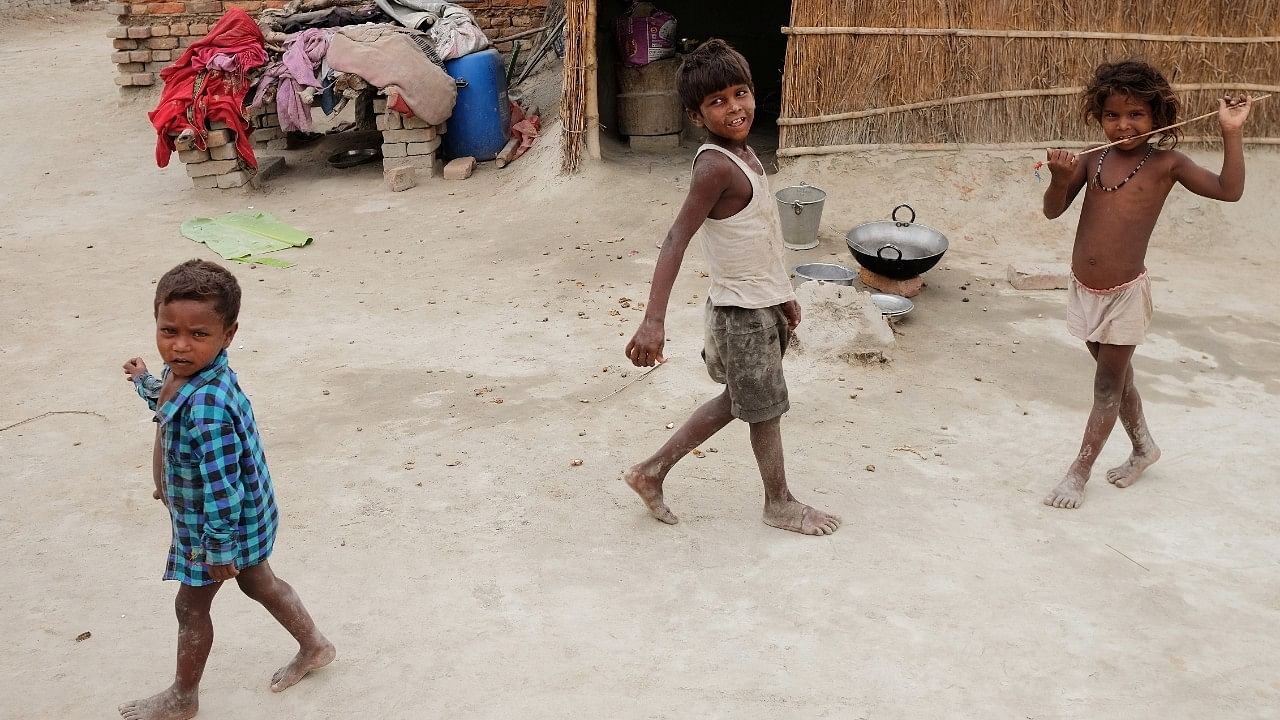
Children showing signs of malnutrition play outside their home in Marwan village in the eastern state of Bihar, India.
Credit: Reuters Photo
Misguided priorities combined with short-term political thinking have made South Asia the epicentre of the world's food insecure-hunger zone, as roughly 1.4 billion (72.2 per cent) people in this region are unable to afford even the cheapest, locally available healthy meal.
According to the Food and Agriculture Organization (FAO)'s latest report, 'Asia and the Pacific - Regional Overview of Food Security and Nutrition 2023, many struggle to manage two square meals for their family. Clearly, government policies on food accessibility and distribution are not working well on the ground.
More inequality, more social unrest
The underlying problem runs deep as 74.1 per cent Indians, 82.8 per cent Pakistanis, 76.4 per cent Nepalis, 66.1 per cent Bangladeshis, and 55.5 per cent Sri Lankans faced serious difficulties and challenges in managing a healthy meal for their family in 2021-2022. Is this an acceptable development standard for any country? Less than 20 per cent of Pakistan could afford a healthy meal!
South Asia is witnessing staggering inequality. To top it, the region has the highest prevalence of anaemia (48.2 per cent) among women aged 15-40 years and the highest prevalence of low birth weight (24.4 per cent). It also reported the highest prevalence of moderate or severe food insecurity for women (42.7 per cent) compared to men (37.3 per cent).
With almost three-fourths of the population in the region staring at a food crisis, national governments here must not lose time and reflect upon "what existing policies, strategies, and institutional mandates support or hinder coherent actions towards food system goals and how to resolve policy incoherence across sectors". Inaction will lead to more hunger, more poverty, greater inequality, and severe social unrest.
Root of the problem
Several unrests across the region since 2020 indicate that a majority of the people in these countries are unable to access basic food items due to high food prices. The 2022 demonstrations in Sri Lanka are a pointer on how food inflation can bring massive social unrest; and if not addressed, it can even topple the government. The annual food price inflation in Sri Lanka was at 85.8 per cent and the prices of non-food items was at 62.8 per cent in the first quarter of 2022.
Bangladesh raised fuel prices by more than 50 per cent, which triggered protests over the rising cost of living. Here, food inflation increased and soared to 12.54 percent in August, which is a 12-year-high according to the Bangladesh Bureau of Statistics. According to a research report, high inflation and rising food prices have led to a reduction in the consumption of meat and fish by 96 per cent and 89 per cent respectively in the last six months.
Nepal's 29 million people are facing a surge in food and energy prices, raising the risk of social unrest. Data released by the Nepal Rastra Bank shows that annual retail inflation accelerated to a six-year high of 7.52 per cent in mid-August. The year-on-year price index of the spices sub-category increased by 45.56 per cent, cereal grains and their products by 13.2 per cent, milk products and eggs by 12.19 per cent, vegetables by 10.8 per cent, ghee and oil by 15.13 per cent — thus, making life for most Nepalis extremely difficult.
In India, food inflation, which accounts for nearly half of the overall consumer price basket, was 8.7 per cent in November. The prices of cereals in India rose by 10.27 per cent and vegetables by 17.7 per cent in November on a year-on-year basis, pulses were up by 20.23 per cent, spices by 21.55 per cent, and fruit prices were up 10.95 per cent as per the November data released by the Ministry of Statistics and Programme Implementation.
Food prices in Pakistan increased 27.95 per cent in November 2023 over the same month in 2022. Food Inflation in Pakistan averaged 10.84 per cent from 2011 until 2023, reaching an all-time high of 48.65 per cent in May 2023.
The above data points to the fact that about 1.5 billion people are in the midst of a crisis struggling to access food with no clear end in sight. Unchecked high food prices are only making the situation worse.
As of today, there is neither a country-level concrete strategy or action plan, nor a joint regional level co-operation mechanism to check food prices. The food security situation will not improve unless governments take a hard position to regulate soaring essential food items. Additionally, the strong US Dollar has further put pressure on the State exchequer in these countries.
Rising food prices continue to squeeze living standards of millions—and taming it should be the priority for national governments in the region.
(Sachi Satapathy is Director, AF Development Care (AFDC).)
Disclaimer: The views expressed above are the author's own. They do not necessarily reflect the views of DH.